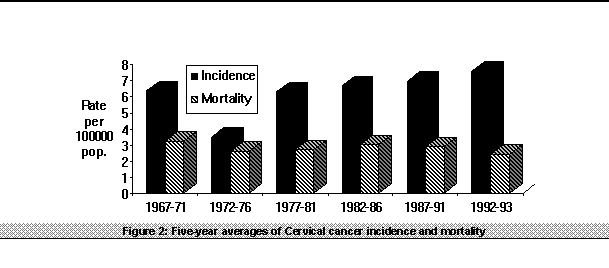
 THE
HEALTH OF THE MALTESE POPULATION
THE
HEALTH OF THE MALTESE POPULATIONHomepage maintained by C. Savona-Ventura
| Home |
| Maltese
Epidemiological Information |
| Maltese
Medical History |
| Maltese Medical Links |
CERVICAL CARCINOMA IN THE MALTESE
POPULATION
MATERIAL AND METHODS
The epidemiological data was obtained from a number of published [4,5,6,7,8] and unpublished sources as listed in Table 1. These sources allowed for the identification of cases of cervical carcinoma, together with the ages of the patients. The age-structure of the population for each year during the period under study 1967-93 was obtained from the annual demographic publication of the Central Office of Statistics [4].

EPIDEMIOLOGY
Death registration by cause of death became a legal requirement before burials in 1870. Publication of mortality statistics by cause of death was initiated in 1872, first as forthnightly reports and after 1896 as departmental annual reports. Legislation regarding cancer notification dates to 1957, while the data collected was published annually after 1960. The accuracy of these reports are dependant on the reliability of practitioners who undertake certification.
The incidence of cervical cancer shows very
wide annual fluctuations
(Figure 1). These fluctuations are the result of the rather small
number
of cases which are reported and the relatively small total female
population.
Figure 1 does however suggest a steady rise in incidence trends in the
last fifteen years. This rise is better observed after assessing the
mean
annual incidence rates over five year perods (Figure 2; Table 2). Thus
the average annual incidence rose from 6.30 per 100000 population in
1977-81
to 6.95 in 1987-91 [7.59 per 100000 population in 1992-93]. The
five-year
average incidence rates thus suggest that there may have been a rise in
the incidence of cervical carcinoma since the late 1970s. The low
average
figure for the period 1972-76 appears not to conform to expected rates,
and the low figure probably reflects discrepancies in registration of
cases.
A similar discrepancy has also been noted for endometrial and breast
malignancy
[9].

Figure 1: Annual Incidence and Mortality Trends: Maltese Islands 1960-1993



The five-year average specific mortality rates suggest that there may have been a drop in the overall mortality rates in the last decade (Table 3). The drop in mortality rates appears evident in all the age groups, except the very elderly >65 years (Table 3). The decrease in mortality rates, in the presence of increasing incidence pattern, suggests that patients are probably being identified at an early stage of the disease allowing for more effective therapy to be instituted.
CONCLUSION
While the incidence of cervical cancer in Malta appears to be gradually on the increase, the rates still remain low in comparison to other European countries (European average 10.1 per 100000 population). Because of the active free-service sceening facilities offered in Government Clinics since 1977, there appears to have been a definate shift in the age at which diagnosis is being made. Cervical cancer is being more and more diagnosed in the younger age group, possibly reflecting early diagnosis resulting from screening and/or earlier onset of disease resulting from earlier sexual activity. In spite of the screening, the specific mortality rates from cervical cancer in Malta have shown little if any change over the years, though they remain significantly lower than those reported in other European countries (European average 4.3 per 100000 population). The possible slight decrease in mortality rates in the last decade in the presence of an increase in incidence rates may reflect the positive advantages of routine cervical screening. This advantage would become more evident if pre-malignant lesions of the cervix (at present non-notifiable) are also considered.
COMPARISON TO EUROPEAN DATA The specific mortality rate from cervical cancer in Malta shows wide fluctuations, but appears to be similar to rates reported from France. The mortality rate appears lower than the European Average but higher than the rates reported from our neighbours - Italy (Table 4). Malta appears to have lower incidence rates for cervical cancer than other European countries.

REFERENCES
1. Rigoni-Stern D.: Fatti Statistici alle malattie Cancerose. Gio. Servire Progr. Path. Terap., 1842, 2:507
2. Savona-Ventura C.: The influence of the Roman Catholic Church on Midwifery Practice in Malta. Medical History, 1995, 39:18-34
3. Savona-Ventura C.: Illegitimacy in the Roman Catholic community of Malta. Planned Parenthood in Europe. 1993, 22(2):30-32
4. C.O.S.: Demographic Review for the Maltese Islands for the years 1960-1993. Central Office of Statistics; Malta, 1961-1994 (annual publications)
5. D.O.H.: Report on the Health Conditions of the Maltese Islands and on the work of the Medical and Health Department for the years 1960-1971. Dept of Health; Malta, 1962-1972 (annual publications)
6. D.O.H.: Vital Statistics and Statistical Information on the Incidence and Mortality of Disease in the Maltese Islands for the years 1972-1980. Dept of Health; Malta, 1973-1981 (annual publications)
7. H.I.S.U.: Cancer Incidence in Malta :1992. Health Information Systems Unit; Malta, 1993.
8. H.I.S.U.: Cancer Incidence and Mortality in Malta: 1993. H.I.S.U.; Malta, 1994
9. Savona-Ventura C. and Grech E.S.: Endometrial carcinoma in the Maltese islands: An epidemiological review. Eur. J. Gynaecol. Onccol., 1986, 7(3):209-217

It would be appreciated if source acknowledgement is made whenever any material is used from this source.
Citation: C. Savona-Ventura: The Health of the Maltese Population. Internet Home Page [http://www.oocities.org/savona.geo/index.html], 1996